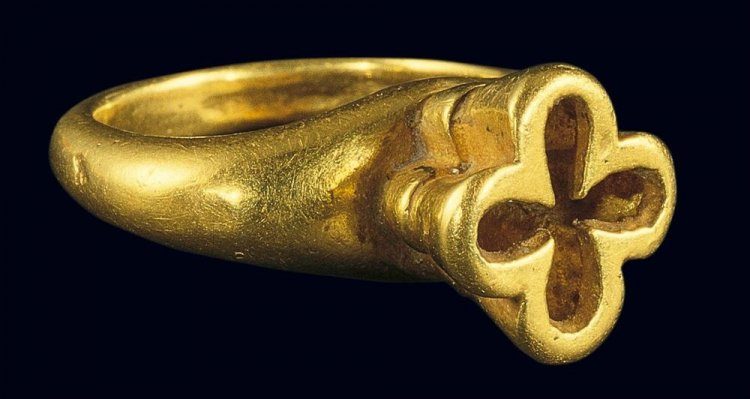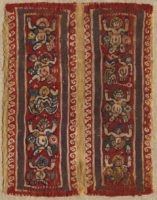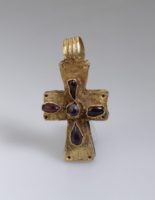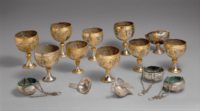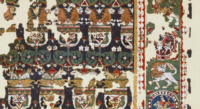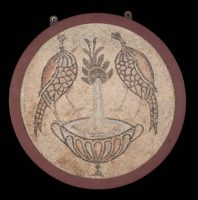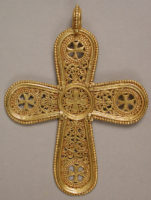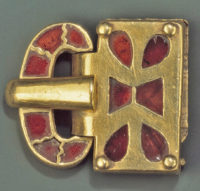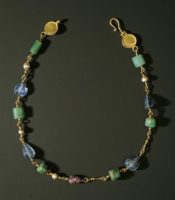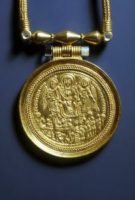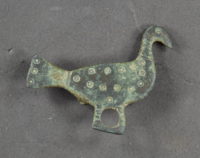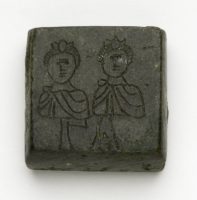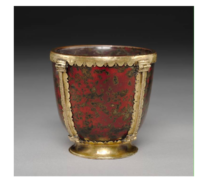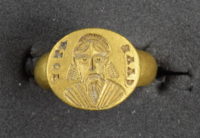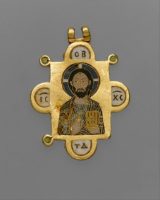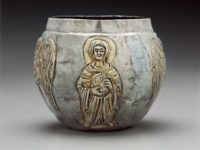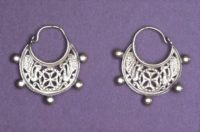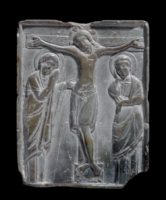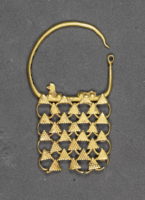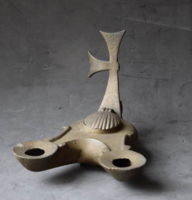Ring with cross-shaped quatrefoil calyx bezel. Materials: gold. Period: Early Byzantine; circa: 6th-7th century. The Benaki Museum of Greek Culture is housed in one of the most beautiful neoclassical-style buildings in Athens, near the National Garden and the Hellenic Parliament.
Fragment, Sleeve Ornament of a Tunic, Period: Early Byzantine, circa: 5th – 7th century. Made in: Egypt. Materials: tabby weave with inwoven tapestry ornament, linen and wool. Overall: 15.6 x 20 cm (6 1/8 x 7 13/16 in.). The Cleveland Art Museum Hours: Tuesdays, Thursdays, Saturdays, Sundays 10:00 a.m.–5:00 p.m. Wednesdays, Fridays 10:00 a.m.–9:00 p.m. Closed Mondays.
Cross, Period: Early Byzantine, circa: 5th-6th century, Materials: golad and garnet. Dimensions: 3,8×1,9 cm. The collection of the State Hermitage includes over 3 million works of art and world culture artefacts. It contains paintings, graphic works, sculptures, works of applied art, archaeological artefacts and numismatic objects. The Hermitage is considered to have been founded in 1764, when Empress Catherine the Great acquired an impressive collection of works from the Berlin merchant Johann Ernst Gotzkowsky. The museum celebrates the anniversary of its founding each year on 7 December, St. Catherine’s Day. Opening Hours: Tuesday, Thursday, Saturday, Sunday: 10.30-18.00 Wednesday, Friday: 10.30-21.00 Closed: Monday.
The Attarouthi Treasure, Period: Early Byzantine, circa: 500-650s. Made in Attarouthi, Syria. Materials: Silver, silver-gilt. On view at The Met Fifth Avenue in Gallery 300.
These well-wrought liturgical items– chalices, censers, a filter, and also a depiction of the dove of the Holy Spirit– were amongst the belongings of a Christian church in the wealthy seller city of Attarouthi in Syria, after that among the wealthiest lands of the Byzantine Empire. The chalices, censers, and also filter were made use of for the Divine Liturgy, or Eucharist, where Christians take consecrated wine and bread in ceremony of the Last Supper and also Christ’s death. According to their inscriptions, written in Greek with several spelling variants, many of the objects were offerings of local citizens to the major church of the town, which was dedicated to Saint Stephen, and to a smaller church dedicated to Saint John (probably Saint John the Forerunner [the Baptist]). In the very early 7th century Syria dropped initially to the Sasanian Persians and afterwards to the militaries of Islam. These works were most likely hidden in haste in a safety container at some minute when the Byzantine military was pulling away from strikes on the area.
The Metropolitan Museum of Art (New York) is one of the world’s largest and finest art museums. Its collection includes more than two million works of art spanning five thousand years of world culture, from prehistory to the present and from every part of the globe. Public Hours: 10:30 a.m.–5:30 p.m. Open seven days a week.
[xyz-ihs snippet="Met-Museum-Booking"]Horse and Lion Hanging, Period: Early Byzantine, 6th century A.D. Materials: wool and linen. The museum is open to the public Tuesday through Sunday, 11:30 a.m.–5:30 p.m., except for federal holidays.
Mosaic, Two Peacocks Perch on a Fountain, Period: Early Byzantine, circa: A.D. 450–462. The MFA is open 7 days a week. Monday and Tuesday 10 am–5 pm, Wednesday–Friday 10 am–10 pm, Saturday and Sunday 10 am–5 pm.
Gold Cross Pendant, Period: Early Byzantine, circa: 500–700s. Material: Gold. Dimensions: 3 9/16 x 2 11/16 x 1/2in. (9 x 6.8 x 1.2cm). On view at The Met Fifth Avenue in Gallery 301. The Metropolitan Museum of Art (New York) is one of the world’s largest and finest art museums. Its collection includes more than two million works of art spanning five thousand years of world culture, from prehistory to the present and from every part of the globe. Public Hours: 10:30 a.m.–5:30 p.m. Open seven days a week.
Buckle with Garnets. Period: Early Byzantine; circa:400–500 A.D. Material: gold. Made in: Constantinople. The Metropolitan Museum of Art (New York) is one of the world’s largest and finest art museums. Its collection includes more than two million works of art spanning five thousand years of world culture, from prehistory to the present and from every part of the globe. Public Hours: 10:30 a.m.–5:30 p.m. Open seven days a week.
Gold necklace with sapphires, amethysts, emeralds and pearls. Period: Early Byzantine. Place/Findspot: Antinoë in Egypt. The Ravenna mosaics portray this kind of precious jewelry, widespread during Early Christian times, being worn by ladies of the imperial court of Theodora.
The Benaki Museum of Greek Culture is housed in one of the most beautiful neoclassical-style buildings in Athens, near the National Garden and the Hellenic Parliament. It was converted into a museum in order to shelter the collections of Antonis Benakis and was donated to the Greek nation by himself and his three sisters, Alexandra, Penelope and Argine. Following its most recent refurbishment (1989–2000), the building houses a unique exhibition on Greek culture arranged diachronically from prehistory to the 20th century.
Enkolpion with Enthroned Virgin, Nativity, Adoration; and Baptism. Period: Early Byzantine Last quarter 6th century (ca. 583). Materials: gold. The museum is open to the public Tuesday through Sunday, 11:30 a.m.–5:30 p.m., except for federal holidays
Brooch, in the form of a dove. Period: Early Byzantine, circa: 6thc-7thc. Material: Bronze . British Museum is closed 24, 25 and 26 December and 1 January, but is open every other day of the year. Fast facts about the British Museum: Founded: 1753, Collection size: 8 million objects, Oldest object in the collection: Stone chopping tool (nearly 2 million years old).
Copper alloy weight, Period: Early Byzantine, circa: 4thC-5thC. Quare with convex profile & chamfered lower edges; engraved on face with 2 imperial busts. British Museum is closed 24, 25 and 26 December and 1 January, but is open every other day of the year. Fast facts about the British Museum: Founded: 1753, Collection size: 8 million objects, Oldest object in the collection: Stone chopping tool (nearly 2 million years old).
Calyx (Chalice), Period: Middle Byzantine, 900s-1000s. Blood jasper (heliotrope) with gilt-copper mounts. The Cleveland Art Museum Hours: Tuesdays, Thursdays, Saturdays, Sundays 10:00 a.m.–5:00 p.m. Wednesdays, Fridays 10:00 a.m.–9:00 p.m. Closed Mondays.
Gold Signet-Ring, plain hoop and applied oval bezel depicts bust of Christ(?). Period: Late Roman – Early Byzantine. 5thC-6thC. Found/Acquired: Rome. British Museum is closed 24, 25 and 26 December and 1 January, but is open every other day of the year. Fast facts about the British Museum: Founded: 1753, Collection size: 8 million objects, Oldest object in the collection: Stone chopping tool (nearly 2 million years old).
Double-Sided Pendant Icon with the Virgin and Christ Pantokrator, Period: Middle Byzantine, circa: 1100. Made in Constantinople. Materials: Gold, cloisonné enamel. On view at The Met Fifth Avenue in Gallery 300. The Metropolitan Museum of Art (New York) is one of the world’s largest and finest art museums. Its collection includes more than two million works of art spanning five thousand years of world culture, from prehistory to the present and from every part of the globe. Public Hours: 10:30 a.m.–5:30 p.m. Open seven days a week.
Spherical Small Container (pyxis) with Representations of Christ, Virgin and two Archangels. Period: Early Byzantine, circa: 6th–7th century A.D. Dimensions: Height x diameter: 7 x 9 cm (2 3/4 x 3 9/16 in.). Materials: Silver with gilding. This gilded silver pyxis of round kind was a container for antiques or scent made use of in Early Byzantine church ceremonies. The 4 figures created in repousse method reveal a bearded Christ offering a true blessing, the Virgin holding a symbol symbolic of her duties as Mother of God (Theotokos), as well as 2 angels worn lengthy sleeved chitons with segmenta on their shoulders and also hems. The cover is shed however could have had a dedicatory inscription.
The MFA is open 7 days a week. Monday and Tuesday 10 am–5 pm, Wednesday–Friday 10 am–10 pm, Saturday and Sunday 10 am–5 pm.
Necklace; Materials: Glass and Amber Beads, mall bone cross and a blue faience figure of Bes. Period: 5thc.-6thc, Early Byzantine. Found: Qaw el-Kebir, Upper Egypt. British Museum is closed 24, 25 and 26 December and 1 January, but is open every other day of the year.
Pair of Loop Earrings; Materials: Gold. Period: Early Byzantine. 6thC-7thC. Subjects: Cross, Peacock. British Museum is closed 24, 25 and 26 December and 1 January, but is open every other day of the year. Fast facts about the British Museum: Founded: 1753, Collection size: 8 million objects, Oldest object in the collection: Stone chopping tool (nearly 2 million years old).
Relief plaque icon, depicting the Crucifixion with full-length figures of the Virgin on the left and St John on the right, Late Byzantine (13 thc). Materials: Steatite – Gold.
Gold Earring; Square; on one face a cheque of triangular groups of pellets, above an animal’s head. Period: Early Byzantine (7thC-8thC ) Found/Acquired: Hims, Syria. British Museum is closed 24, 25 and 26 December and 1 January, but is open every other day of the year. Fast facts about the British Museum: Founded: 1753, Collection size: 8 million objects, Oldest object in the collection: Stone chopping tool (nearly 2 million years old).
Lamp for a Stand, Period: Early Byzantine circa: 5thC-7thC. Found/Acquired: Damanhûr, Nile Delta. Materials: Bronze. British Museum is closed 24, 25 and 26 December and 1 January, but is open every other day of the year. Fast facts about the British Museum: Founded: 1753, Collection size: 8 million objects, Oldest object in the collection: Stone chopping tool (nearly 2 million years old).


